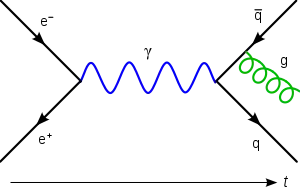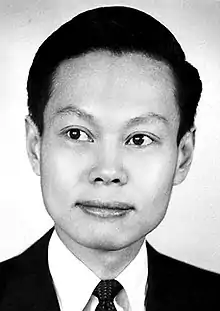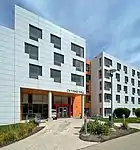| Modern physics |
|---|
| |
Yang Chen-Ning or Chen-Ning Yang (Chinese: 杨振宁; pinyin: Yáng Zhènníng; born 1 October 1922),[1] also known as C. N. Yang or by the English name Frank Yang,[2] is a Chinese theoretical physicist who made significant contributions to statistical mechanics, integrable systems, gauge theory, and both particle physics and condensed matter physics. He and Tsung-Dao Lee received the 1957 Nobel Prize in Physics[3] for their work on parity non-conservation of weak interaction. The two proposed that one of the basic quantum-mechanics laws, the conservation of parity, is violated in the so-called weak nuclear reactions, those nuclear processes that result in the emission of beta or alpha particles. Yang is also well known for his collaboration with Robert Mills in developing non-abelian gauge theory, widely known as the Yang–Mills theory.
Early life and education
Yang was born in Hefei, Anhui, China. His father, Ko-Chuen Yang (楊克純; 1896–1973), was a mathematician, and his mother, Meng Hwa Loh Yang (羅孟華), was a housewife.
Yang attended elementary school and high school in Beijing, and in the autumn of 1937 his family moved to Hefei after the Japanese invaded China. In 1938 they moved to Kunming, Yunnan, where National Southwestern Associated University was located. In the same year, as a second year student, Yang passed the entrance examination and studied at National Southwestern Associated University. He received a Bachelor of Science in 1942,[2] with his thesis on the application of group theory to molecular spectra, under the supervision of Ta-You Wu.
Yang continued to study graduate courses there for two years under the supervision of Wang Zhuxi, working on statistical mechanics. In 1944, he received a Master of Science from Tsinghua University, which had moved to Kunming during the Sino-Japanese War (1937–1945).[2] Yang was then awarded a scholarship from the Boxer Indemnity Scholarship Program, set up by the United States government using part of the money China had been forced to pay following the Boxer Rebellion. His departure for the United States was delayed for one year, during which time he taught in a middle school as a teacher and studied field theory.
Yang entered the University of Chicago in January 1946 and studied with Edward Teller. He received a Doctor of Philosophy in 1948.[2]
Career
Yang remained at the University of Chicago for a year as an assistant to Enrico Fermi. In 1949 he was invited to do his research at the Institute for Advanced Study in Princeton, New Jersey, where he began a period of fruitful collaboration with Tsung-Dao Lee. He was made a permanent member of the Institute in 1952, and full professor in 1955. In 1963, Princeton University Press published his textbook, Elementary Particles. In 1965 he moved to Stony Brook University, where he was named the Albert Einstein Professor of Physics and the first director of the newly founded Institute for Theoretical Physics. Today this institute is known as the C. N. Yang Institute for Theoretical Physics.
Yang retired from Stony Brook University in 1999, assuming the title Emeritus Professor. In 2010, Stony Brook University honored Yang's contributions to the university by naming its newest dormitory building C. N. Yang Hall.[4]
Yang has been elected a Fellow of the American Physical Society, the Chinese Academy of Sciences, the Academia Sinica, the Russian Academy of Sciences, and the Royal Society. He was an elected member of the American Academy of Arts and Sciences,[5] the American Philosophical Society,[6] and the United States National Academy of Sciences.[7] He was awarded honorary doctorate degrees by Princeton University (1958), Moscow State University (1992), and the Chinese University of Hong Kong (1997).
Yang visited the Chinese mainland in 1971 for the first time after the thaw in China–US relations, and has subsequently worked to help the Chinese physics community rebuild the research atmosphere which was destroyed by the radical political movements during the Cultural Revolution. After retiring from Stony Brook he returned as an honorary director of Tsinghua University, Beijing, where he is the Huang Jibei-Lu Kaiqun Professor at the Center for Advanced Study (CASTU). He is also one of the two Shaw Prize Founding Members and is a Distinguished Professor-at-Large at the Chinese University of Hong Kong.
Personal life
Yang married Chih-li Tu (pinyin: Dù Zhìlǐ), a teacher, in 1950 and has two sons and a daughter with her: Franklin Jr., Gilbert and Eulee. His father-in-law was the Kuomintang general Du Yuming. Some scholars suspect that Du was promoted to a high-ranking position in the Chinese People's Political Consultative Conference in order to convince Yang to return to China after seeking refuge in the US. Tu died in October 2003, and in December 2004 the then 82-year-old Yang caused a stir by marrying the then 28-year-old Weng Fan (Chinese: 翁帆; pinyin: Wēng Fān), calling Weng the "final blessing from God".[8] Yang formally renounced his U.S. citizenship in late 2015.[9] On 1 October 2022, Yang became a centenarian.[10]
Academic achievements
| Quantum field theory |
|---|
 |
| History |
| Standard Model of particle physics |
|---|
 |
| Condensed matter physics |
|---|
 |
|
| Statistical mechanics |
|---|
 |
Yang has worked on statistical mechanics, condensed matter theory, particle physics and gauge theory/quantum field theory.
At the University of Chicago, Yang first spent twenty months working in an accelerator lab, but he later found he was not as good as an experimentalist and switched back to theory. His doctoral thesis was about angular distribution in nuclear reactions.
Yang is well known for his 1953 collaboration with Robert Mills in developing non-abelian gauge theory, widely known as the Yang–Mills theory. The idea was generally conceived by Yang, and the novice scientist Mills assisted him in this endeavor as Mills said,
"During the academic year 1953-1954, Yang was a visitor to Brookhaven National Laboratory...I was at Brookhaven also...and was assigned to the same office as Yang. Yang, who has demonstrated on a number of occasions his generosity to physicists beginning their careers, told me about his idea of generalizing gauge invariance and we discussed it at some length...I was able to contribute something to the discussions, especially with regard to the quantization procedures, and to a small degree in working out the formalism; however, the key ideas were Yang's."[11]
Subsequently, in the last three decades, many other prominent scientists have developed key breakthroughs to what is now known as gauge theory.
Later he worked on particle phenomenology; a well-known work was the Fermi–Yang model treating pion meson as a bound nucleon–anti-nucleon pair. In 1956, he and Tsung Dao (T.D.) Lee proposed that in the weak interaction the parity symmetry was not conserved, Chien-shiung Wu's team at the National Bureau of Standards in Washington experimentally verified the theory. Yang and Lee received the 1957 Nobel Prize in Physics for their parity violation theory, which brought revolutionary change to the field of particle physics.[3] Yang has also worked on neutrino theory with Tsung Dao (T.D.) Lee, 1957, 1959, CT nonconservation (with Tsung Dao (T.D.) Lee and R. Oheme, 1957), electromagnetic interaction of vector mesons (with Tsung Dao (T.D.) Lee, 1962), CP nonconservation with Tai Tsun Wu (1964).
In the 1970s Yang worked on the topological properties of gauge theory, collaborating with Wu Tai-Tsun to elucidate the Wu–Yang monopole. Unlike the Dirac monopole, it has no singular Dirac string. Also devised the Wu–Yang dictionary, the Yang-Mills theory set the template for the Standard Model and modern physics in general, as well as the work towards a Grand Unified Theory; it was called by The Scientist, "the foundation for current understanding of how subatomic particles interact, a contribution which has restructured modern physics and mathematics."[12]
Yang has had a great interest in statistical mechanics since his undergraduate time. In the 1950s and 1960s, he collaborated with Tsung Dao (T.D.) Lee and Kerson Huang, etc. and studied statistical mechanics and condensed matter theory. He studied the theory of phase transition and elucidated the Lee–Yang circle theorem, properties of quantum boson liquid, two dimensional Ising model, flux quantization in superconductors (with N. Byers, 1961), and proposed the concept of Off-Diagonal Long-Range Order (ODLRO, 1962). In 1967, he found a consistent condition for a one dimensional factorized scattering many body system, the equation was later named the Yang–Baxter equation, it plays an important role in integrable models and has influenced several branches of physics and mathematics.
Awards and honors
- Nobel Prize in Physics (1957)[3]
- Ten Outstanding Young Americans (1957)[13]
- Rumford Prize (1980) [14]
- National Medal of Science (1986)[15]
- Oskar Klein Memorial Lecture and Medal (1988)[16]
- Benjamin Franklin Medal for Distinguished Achievement in the Sciences of the American Philosophical Society (1993)[17]
- Bower Award (1994)[18]
- Albert Einstein Medal (1995)[19]
- Lars Onsager Prize (1999)[20]
- King Faisal International Prize (2001)[21]
- C.N. Yang Hall, a residence hall and activity center at Stony Brook University, was dedicated in 2010.[22]
Selected publications
- Collected works
- Yang, C. N. (1983). Selected Papers, 1945–1980, with Commentary. San Francisco, CA: W. H. Freeman & Co. ISBN 978-0-7167-1406-4.
- Yang, Chen-Ning (2005) [1983]. Selected Papers, 1945–1980, with Commentary. World Scientific Series in 20th Century Physics. Vol. 36 (2005 ed.). Singapore: World Scientific. ISBN 981-256-367-9.
- Yang, Chen-Ning (2013). Selected Papers of Chen Ning Yang II: With Commentaries. Singapore: World Scientific. ISBN 978-981-4449-00-7.
- Yang, C. N.; Mills, R. L. (1954). "Conservation of Isotopic Spin and Isotopic Gauge Invariance". Physical Review. 96 (1): 191–195. Bibcode:1954PhRv...96..191Y. doi:10.1103/PhysRev.96.191.
- Mills, R. L.; Yang, C. N. (1966). "Treatment of Overlapping Divergences in the Photon Self-Energy Function". Progress of Theoretical Physics Supplement. 37: 507. Bibcode:1966PThPS..37..507M. doi:10.1143/PTPS.37.507.
- Yang, C. N. (2005). "Remembering Robert Mills". In 't Hooft, Gerardus (ed.). 50 years of Yang-Mills theory. Singapore: World Scientific. ISBN 978-981-238-934-3.
- Lee, T. D.; Yang, C. N. (1956). "Question of Parity Conservation in Weak Interactions". Physical Review. 104 (1): 254–258. Bibcode:1956PhRv..104..254L. doi:10.1103/PhysRev.104.254. S2CID 2044624.
- Lee, T. D.; Yang, C. N. (1952). "Statistical Theory of Equations of State and Phase Transitions. II. Lattice Gas and Ising Model". Physical Review. 87 (3): 410–419. Bibcode:1952PhRv...87..410L. doi:10.1103/PhysRev.87.410. ISSN 0031-9007.
- Byers, N.; Yang, C. N. (1961). "Theoretical Considerations Concerning Quantized Magnetic Flux in Superconducting Cylinders". Physical Review Letters. 7 (2): 46–49. Bibcode:1961PhRvL...7...46B. doi:10.1103/PhysRevLett.7.46.
See also
Bibliography
- Interpretation of Organic Spectra, Wiley, 2011[23]
References
Citations
- 1 2 Li, Bing-An; Deng, Yuefan. "Biography of C.N. Yang" (PDF). Retrieved 11 September 2007.
His birth date was erroneously recorded as September 22, 1922 in his 1945 passport. He has since used this incorrect date on all subsequent official documents.
- 1 2 3 4 "Chen Ning Yang - Biographical". nobelprize.org. The Nobel Prize. Retrieved 29 June 2022.
- 1 2 3 "The Nobel Prize in Physics 1957". The Nobel Foundation. Retrieved 1 November 2014.
- ↑ "Exclusive: New Dorm Likely to Honor Nobel Laureate". Thinksb.com. 18 March 2010. Archived from the original on 17 July 2011. Retrieved 6 May 2011.
- ↑ "Chen Ning Yang". American Academy of Arts & Sciences. Retrieved 11 October 2022.
- ↑ "APS Member History". search.amphilsoc.org. Retrieved 11 October 2022.
- ↑ "Chen N. Yang". www.nasonline.org. Retrieved 11 October 2022.
- ↑ "Chen Ning Yang, 82, to marry a 28-year-old woman". China Daily. 16 December 2014.
- ↑ "Two top Chinese-American scientists have dropped their U.S. citizenship". Science. 24 February 2017.
- ↑ "Celebrating Chen Ning Yang at 100 - IAS News | Institute for Advanced Study". www.ias.edu. 21 September 2022. Retrieved 30 September 2022.
- ↑ Gray, Jeremy; Wilson, Robin (6 December 2012). Mathematical Conversations: Selections from The Mathematical Intelligencer. Springer Science & Business Media. p. 63. ISBN 9781461301950.
- ↑ Ravo, Nick (2 October 1999). "Robert L. Mills, 72, Theorist In Realm of Subatomic Physics". The New York Times.
- ↑ Richards, Allen (1957). "Chen Ning Yang and other recipients of the USJCC's 1957 Ten Outstanding Young Men". Institute for Advanced Study. Retrieved 29 June 2022.
- ↑ "Past Prizes". American Academy of Arts & Sciences. Retrieved 29 June 2022.
- ↑ "The President's National Medal of Science: Recipient Details | NSF - National Science Foundation". www.nsf.gov. National Science Foundation. Retrieved 29 June 2022.
- ↑ "Earlier Lectures - Oskar Klein Centre". www.okc.albanova.se. Stockholm University. Archived from the original on 4 November 2020. Retrieved 29 June 2022.
- ↑ "Benjamin Franklin Medal for Distinguished Achievement in the Sciences Recipients". American Philosophical Society. Retrieved 26 November 2011.
- ↑ "Chen Ning Yang". The Franklin Institute. 15 January 2014. Retrieved 29 June 2022.
- ↑ "Einstein Society". www.einstein-bern.ch. Retrieved 29 June 2022.
- ↑ "1999 Lars Onsager Prize Recipient". www.aps.org. American Physical Society. Retrieved 29 June 2022.
- ↑ "King Faisal Prize - Professor Chen Ning Yang". kingfaisalprize.org. King Faisal Prize. Retrieved 29 June 2022.
- ↑ "C.N. Yang Hall Dedication Ceremony". Stony Brook University. 23 April 2010. Retrieved 27 November 2022.
- ↑ Ning, Yong-Cheng. (2011). Interpretation of organic spectra. Hoboken, NJ: Wiley. ISBN 978-0-470-82518-1. OCLC 729726196.
Sources
- Yang, C. N. (1952). Special problems of statistical mechanics. Seattle, WA: University of Washington Press. ASIN B0007FZHH4.
- Lee, T. D. and Yang, C. N. "Elementary Particles and Weak Interactions", Brookhaven National Laboratory (BNL), United States Department of Energy (through predecessor agency the Atomic Energy Commission), (1957).
- Yang, C. N. "The Many Body Problem. Physics Monographs No. 6," Rio de Janeiro. Centro Brasileiro de Pesquisas Fisicas, (1960).
- Yang, C. N. (1963) [1961]. Elementary Particles: A Short History of Some Discoveries in Atomic Physics. Princeton, NJ: Princeton University Press. ASIN B000E1CBGG.
- Yang, C. N. "Mathematical Deductions from Some Rules Concerning High-Energy Total Cross Sections," Brookhaven National Laboratory (BNL), United States Department of Energy (through predecessor agency the Atomic Energy Commission), (1962).
- Yang, C. N. "Symmetry Principles In Physics. Brookhaven Lecture Series Number 50," Brookhaven National Laboratory (BNL), United States Department of Energy (through predecessor agency the Atomic Energy Commission), (13 October 1965).
- Yang, C. N. (1983). Selected papers 1945–1980, with commentary (Chen Ning Yang). San Francisco, CA: W.H. Freeman. ISBN 978-0-7167-1406-4.
- "C.N. Yang Institute for Theoretical Physics (YITP)". Retrieved 5 January 2008.
- Sutherland, Bill (2004). Beautiful Models. Singapore: World Scientific. ISBN 978-981-238-859-9.
External links
 Media related to Chen Ning Yang at Wikimedia Commons
Media related to Chen Ning Yang at Wikimedia Commons Quotations related to Yang Chen-Ning at Wikiquote
Quotations related to Yang Chen-Ning at Wikiquote- Professor Chen Ning Yang (homepage – Institute for Advanced Study, Tsinghua University)
- Chen Ning Yang (homepage – Stony Brook University)
- C.N. Yang's Home Page (homepage – The Chinese University of Hong Kong)
- Yang Chen-Ning on Nobelprize.org including the Nobel Lecture, 11 December 1957 The Law of Parity Conservation and Other Symmetry Laws of Physics
- The Shaw Prize, Structure Archived 31 October 2016 at the Wayback Machine (homepage – Shaw Prize)
- Symmetries and Reflections (C.N. Yang retirement symposium at Stony Brook University)
- The CN Yang Scholars Programme Archived 7 June 2011 at the Wayback Machine at Nanyang Technological University Archived 22 April 2011 at the Wayback Machine, Singapore
- "Chen-ning Yang interview". Simons Foundation. 20 December 2011.


.jpg.webp)
